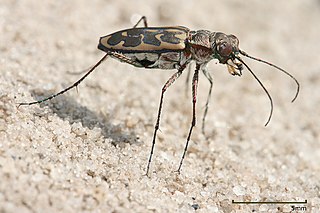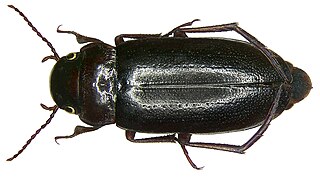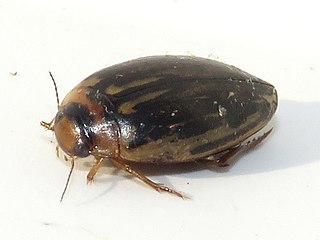
Tiger beetles are a family of beetles, Cicindelidae, known for their aggressive predatory habits and running speed. The fastest known species of tiger beetle, Rivacindela hudsoni, can run at a speed of 9 km/h, or about 125 body lengths per second. As of 2005, about 2,600 species and subspecies were known, with the richest diversity in the Oriental (Indo-Malayan) region, followed by the Neotropics. While historically treated as a subfamily of ground beetles (Carabidae) under the name Cicindelinae, several studies since 2020 indicated that they should be treated as a family, the Cicindelidae, which are a sister group to Carabidae within the Adephaga.

The whirligig beetles are water beetles, comprising the family Gyrinidae that usually swim on the surface of the water if undisturbed, though they swim underwater when threatened. They get their common name from their habit of swimming rapidly in circles when alarmed, and are also notable for their divided eyes which are believed to enable them to see both above and below water. The family includes some 700 extant species worldwide, in 15 genera, plus a few fossil species. Most species are very similar in general appearance, though they vary in size from perhaps 3 mm to 18 mm in length. They tend to be flattened and rounded in cross section, in plain view as seen from above, and in longitudinal section. In fact their shape is a good first approximation to an ellipsoid, with legs and other appendages fitting closely into a streamlined surface. Whirligig beetles belong to the beetle suborder Adephaga, which also includes ground beetles and diving beetles.

The Adephaga are a suborder of beetles, and with more than 40,000 recorded species in 10 families, the second-largest of the four beetle suborders. Members of this suborder are collectively known as adephagans. The largest family is Carabidae which comprises most of the suborder with over 40,000 species. Adephaga also includes a variety of aquatic beetles, such as predaceous diving beetles and whirligig beetles.

The Trachypachidae are a family of beetles that generally resemble small ground beetles, but that are distinguished by the large coxae of their rearmost legs. There are only six known extant species in the family, with four species of Trachypachus found in northern Eurasia and northern North America, and two species of Systolosoma in Chile and Argentina. They were much more diverse in the past, with dozens of described species from the Mesozoic.

Amphizoa is a genus of aquatic beetles in the suborder Adephaga, placed in its own monogeneric family, Amphizoidae. There are five known species of Amphizoa, three in western North America and two in the eastern Palearctic. They are sometimes referred to by the common name troutstream beetles.

The Dytiscidae – based on the Greek dytikos (δυτικός), "able to dive" – are the predaceous diving beetles, a family of water beetles. They occur in virtually any freshwater habitat around the world, but a few species live among leaf litter. The adults of most are between 1 and 2.5 cm (0.4–1.0 in) long, though much variation is seen between species. The European Dytiscus latissimus and Brazilian Megadytes ducalis are the largest, reaching up to 4.5 cm (1.8 in) and 4.75 cm (1.9 in) respectively. In contrast, the smallest is likely the Australian Limbodessus atypicali of subterranean waters, which only is about 0.9 mm (0.035 in) long. Most are dark brown, blackish, or dark olive in color with golden highlights in some subfamilies. The larvae are commonly known as water tigers due to their voracious appetite. They have short, but sharp mandibles and immediately upon biting, they deliver digestive enzymes into prey to suck their liquefied remains. The family includes more than 4,000 described species in numerous genera.

Myxophaga is the second-smallest suborder of the Coleoptera after Archostemata, consisting of roughly 65 species of small to minute beetles in four families. The members of this suborder are aquatic and semiaquatic, and feed on algae.

Rhantus is a genus of beetle in family Dytiscidae. There are about 100 species distributed worldwide. They often live in pools and marshy habitat types. Several species have colonized oceanic islands and become endemics.
Rhysodinae is a subfamily in the family Carabidae. There are 19 genera and at least 380 described species in Rhysodinae. The group of genera making up Rhysodinae had been treated as the family Rhysodidae in the past, and subsequent DNA analysis then placed it within Carabidae, where it was sometimes treated as the tribe Rhysodini, but the most recent analyses place it as a subfamily in a clade along with subfamilies Paussinae and Siagoninae, forming a sister to the remaining Carabidae.

Carabdytes is a genus of predaceous diving beetles in the family Dytiscidae. Carabdytes upin was formerly the sole species of this genus, but nine species in the genus Rhantus were transferred to Carabdytes as a result of research published by Balke et al. in 2017.

Coptotomus is a genus of predaceous diving beetles in the family Dytiscidae, the only genus of the subfamily Coptotominae. There are about six described species in Coptotomus, found in North America and the Neotropics.

Hydrocanthus is a genus of beetles in the family Noteridae, containing the following species:
Aspidytes is a genus of aquatic beetles in the family Aspidytidae, first recorded in 2002 from specimens in South Africa. The genus contains the single species Aspidytes niobe. Originally a second species from China was placed in the same genus but has later been transferred to Sinaspidytes. The aquatic beetle is 6.5 - 7.2 mm long and lives in hygropetric habitats.
Carabdytes plantaris is a naturally uncommon species of diving beetle in the family Dytiscidae. It is endemic to New Zealand. For over a century, it was known from just a single specimen collected in 1880 "near Dunedin", and doubts were cast on whether it was actually a New Zealand species at all. In 1986, it was rediscovered when several were collected from a roadside pond near Lake Ellesmere. Carabdytes plantaris is now classed as "naturally uncommon" by the Department of Conservation.

Nartus grapii is a species of beetle in family Dytiscidae, found in the Palearctic. This species was formerly a member of the genus Rhantus.
Bidessini is a tribe of predaceous diving beetles in the family Dytiscidae. There are at least 40 genera and at least 630 described species in Bidessini.

Neobidessodes is a genus of predaceous diving beetles in the family Dytiscidae. There are about 10 described species in Neobidessodes. They are found in Australasia. The genus was first described in 2009, and the type species is N. denticulatus.

Aspidytidae is a family of aquatic beetles of the suborder Adephaga, described in 2002 from specimens in South Africa and China. There are only two known species in the family and these were originally described in the genus Aspidytes, but later the new genus Sinaspidytes was erected for the species found in China. The family can also be referred to by its trivial name cliff water beetles.

Peltochares is a genus of water scavenger beetles in the family Hydrophilidae represented by eight described species. It is distributed across the Afrotropical, Australasian, Indo-Malayan, and Palaearctic realms.

Sinaspidytes is a genus of aquatic beetles in Aspidytidae, first recorded in 2003 from specimens in the Shaanxi province, China. It is monotypic, with the only species being Sinaspidytes wrasei. Originally this species was placed in the genus Aspidytes with a second species from South Africa, but was later transferred to Sinaspidytes. The genus contains the single species S. wrasei. The aquatic beetle is 4.8 - 5.2 mm long and lives in hygropetric habitats.















